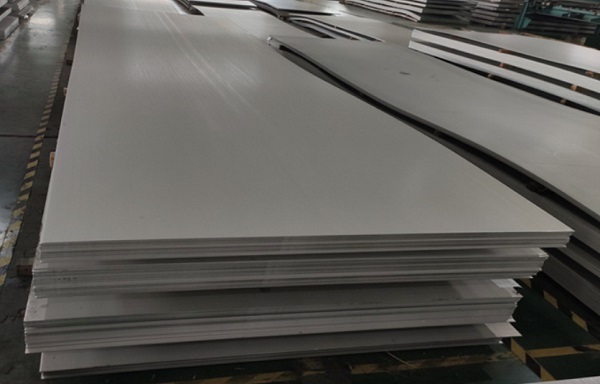Categories
- Pipe & Tube (18)
- Flange & Fitting (97)
- Fastener & Gasket (12)
- Valve & Pump (18)
- Base Material (11)
- Equipment (8)
- Application (30)
- Technical (110)
Plates made of ASTM A240/ ASME SA-240 Type 316Ti is a typical molybdenum-bearing austenitic stainless steel stabilized with titanium. They are primarily used for pressure vessels and for general applications including architectural, building, construction, and aesthetic applications. Type 316Ti has the nominal composition of 16Cr-12Ni-2Mo-Ti with UNS designation S31635. Its European equivalent is EN 10028-7 1.4571/ X6CrNiMoTi17-12-2.
Type 316Ti is more resistant to atmospheric and other mild types of corrosion than the 18Cr-8Ni stainless steels. It is especially more resistant than any of the other chromium-nickel types to sulfuric acid solutions. The resistance of Type 316Ti to pitting or crevice corrosion in the presence of chloride or other halide ions is enchanced by high chromium and molybdenum content. The pitting resistance equivalent number (PREN) value of Type 316 Ti is usually higher than 23.0. In fact, it may handle solutions with up to about 2000 ppm chloride.

ASTM A240 Type 316Ti plates supplied to Austria; 1500 mm x 5000 mm x 12 mm.
Compared to conventional Type 316 stainless steel, the titanium addition of Type 316Ti ties up the carbon content by the formation of titanium carbides avoiding chromium depletion when the steel is exposed in the sensitization temperature range for long periods of time. Thus, susceptibility to intergranular corrosion can be eliminated when properly heat treated. Although exhibiting improved resistance to SCC, it is still quite susceptible in halide environments. Besides, ASTM A240 Type 316Ti plate exhibit excellent resistance to oxidation and a low rate of scaling in air atmospheres at temperatures up to 1600-1650°F [870-900°C]. Type 316Ti may be subject to catastrophic oxidation at high temperatures in stagnant air atmospheres, such as in the heat treatment of closely packed items. This occurs due to the formation of low melting molybdenum trioxide (MoO3), which reacts with the alloy causing deep pitting and metal loss. When air is allowed to circulate, the MoO3 will evaporate from the metal surface and excessive oxidation is avoided.
| Element | Composition, % |
|---|---|
| C | ≤0.08 |
| Mn | ≤2.00 |
| P | ≤0.045 |
| S | ≤0.030 |
| Si | ≤0.75 |
| Cr | 16.0-18.0 |
| Ni | 10.0-14.0 |
| Mo | 2.00-3.00 |
| N | ≤0.10 |
| Ti | *Note |
| Mechanical Test | Requirements |
|---|---|
| Tensile Strength min. MPa [ksi] | 515 [75] |
| Yield Strength min. MPa [ksi] | 205 [30] |
| Elongation in 2", min. % | 40 |
| Hardness, max. Brinell HBW | 217 |
| Hardness, max. Rockwell HRBW | 95 |
ASTM A240 316Ti plates shall be made by a hot rolling or cold rolling process depending on buyer’s requirements. The steel shall be made by the electric-arc furnace usually followed by an electroslag remelting process. The plates shall be provided with solution annealing heat treatment, in which it is soaked in the 1900-2150°F [1040-1175°C] temperature range followed by a water quench. To achieve optimum corrosion resistance, subsequent stabilizing heat treatment may be performed. Since chromium carbides dissolve at a lower temperature range than titanium carbides, usually the stabilizing temperature is controlled between 1550-1650°F [845-900°C] at which titanium carbides will precipitate but chromium is still in solution. After soaking in the stabilizing temperature for at least 2 hours, the Type 316Ti plates shall be rapidly cooled by air.
ASME SA-240/ ASTM A240 316Ti plates can be used for the construction of pressure vessels according to ASME BPVC Section VIII Division 1 with the minimum and maximum design temperature of -20°F [-29°C] and 1500°F [815°C] respectively. The plates can also be used for the construction of transport tanks according to Section XII with the minimum and maximum design temperature of -20°F [-29°C] and 650°F [343°C] respectively.
| Temp. °F | S, ksi | S', ksi |
|---|---|---|
| 100 | 20.0 | 20.0 |
| 200 | 20.0 | 17.7 |
| 300 | 20.0 | 15.8 |
| 400 | 19.4 | 14.3 |
| 500 | 17.8 | 13.2 |
| 600 | 16.8 | 12.4 |
| 650 | 16.5 | 12.2 |
| 700 | 16.2 | 12.0 |
| 750 | 16.0 | 11.9 |
| 800 | 15.9 | 11.8 |
| 850 | 15.8 | 11.7 |
| 900 | 15.7 | 11.6 |
| 950 | 15.5 | 11.5 |
| 1000 | 15.3 | 11.4 |
| 1050 | 15.1 | 11.2 |
| 1100 | 12.3 | 11.0 |
| 1150 | 9.8 | 9.8 |
| 1200 | 7.4 | 7.4 |
| 1250 | 5.5 | 5.5 |
| 1300 | 4.1 | 4.1 |
| 1350 | 3.1 | 3.1 |
| 1400 | 2.3 | 2.3 |
| 1450 | 1.7 | 1.7 |
| 1500 | 1.3 | 1.3 |
